Spinning Mule
History
The Spinning Mule or mule spinner is a machine used to spin cotton and other fibers in the mills. It was invented by Samuel Crompton in 1779. The spinning mule spins textile fibers into yarn by an intermittent process. In the draw stroke, the roving is pulled through and twisted; on the return, it is wrapped onto the spindle.


Design and Mechanism
The spinning mule consists of a fixed frame with a creel of bobbins to hold the roving, connected through the headstock to a parallel carriage with the spindles. The headstock moves out drawing and twisting the roving, then the carriage moves in, winding the newly spun yarn onto the spindle. The movement is controlled by a series of gears, called the 'complicated' or 'compound' wheel, which adjusts the timing and extent of the draw.
Evolution and Improvement
The spinning mule underwent several improvements since its inception. The early mules were manually operated. Later, the process was mechanized with the introduction of steam power. The mule jenny, a hybrid between the spinning jenny and the spinning mule, was developed to produce a finer thread. The self-acting (automatic) mule was a major development, which eliminated the need for manual labor in its operation.
Impact on the Textile Industry
The spinning mule had a profound impact on the textile industry. It allowed for greater control over the weaving process, and the production of a more consistent, higher quality yarn. This led to the widespread adoption of the spinning mule in textile mills, and it became a key component of the Industrial Revolution.
Modern Usage
Today, the spinning mule is largely obsolete, having been replaced by the ring spinner. However, mules are still used in specialty mills to spin high-quality woolen yarns.
